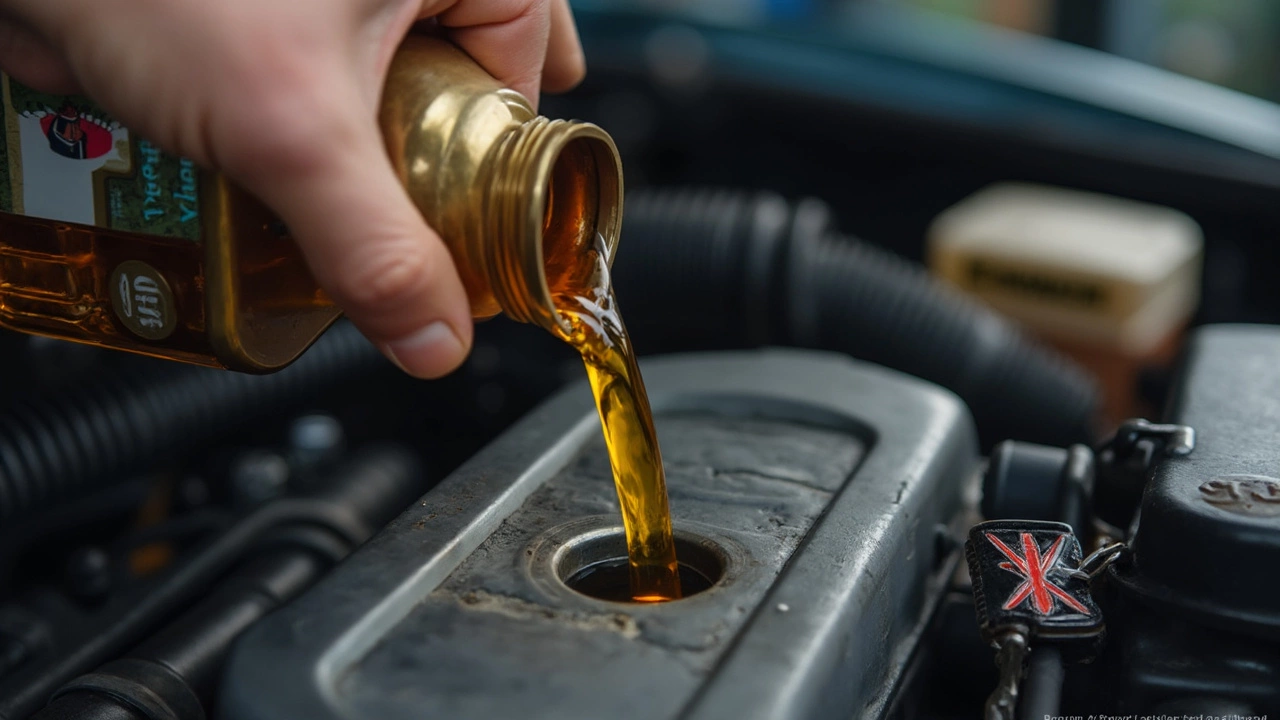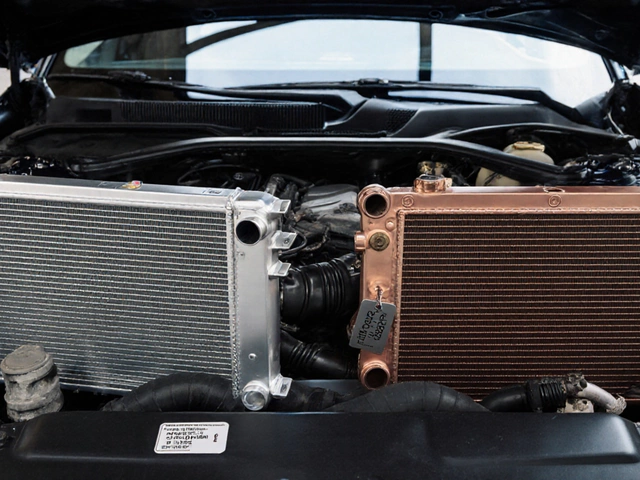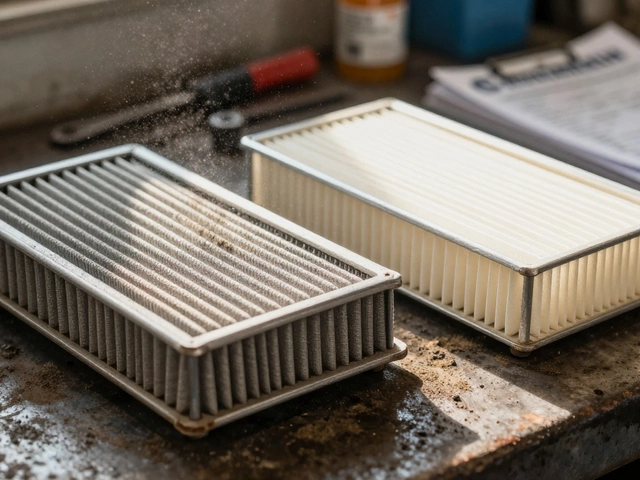Ever seen that little oil can symbol light up on your dashboard and wondered if topping off your oil is enough to keep things running? You’re definitely not alone. Engine oil isn’t just there for show—it’s the stuff that keeps all those moving parts from grinding each other to bits. But just adding oil over and over doesn’t fix every problem.
If your oil level is low, adding more can help in a pinch. That said, there’s more to it than just pouring new oil in and calling it good. The old oil in your car breaks down over time and picks up lots of dirt and tiny bits of metal. Adding fresh oil might raise the level, but it won’t magically clean out the gunk or restore the protective qualities your engine needs. So, while top-ups are useful when you’re running low, they’re not a substitute for a real oil change.
- Why Engine Oil Matters
- Can You Just Add Oil?
- How to Check and Top Up Safely
- When a Full Oil Change Is Needed
Why Engine Oil Matters
When it comes to keeping your car healthy, nothing works harder behind the scenes than engine oil. It does the heavy lifting in three big ways: lubricating moving parts, cooling things off, and scrubbing away gunk. If you skip out on oil, your engine doesn’t just run rough—it can actually destroy itself over time.
The oil coats metal parts to cut down on friction. No oil means metal scraping on metal, and that spells trouble fast—overheated parts, major wear, and even total engine failure. According to the American Automobile Association (AAA), most engine failures are linked to neglecting oil changes or letting oil run low. That’s a preventable disaster.
Engine oil also helps manage heat. Engines get super hot when running, and oil carries heat away from the hottest spots. Think about the temperature under your hood—it can go over 220°F during regular driving. Oil keeps things under control so your car doesn’t end up steaming by the side of the road.
Besides lubrication and cooling, oil grabs hold of dirt, dust, and tiny metal pieces floating around inside your engine. This stuff gets trapped in the oil filter, keeping your engine cleaner for longer. Dirty oil can turn into sludge, blocking small oil passages and starving critical parts, which is why fresh oil is a must.
| Function | What It Prevents | Risk If Ignored |
|---|---|---|
| Lubrication | Wear & Tear | Engine damage, failure |
| Cooling | Overheating | Warped parts, breakdown |
| Cleaning | Sludge & buildup | Clogs, poor performance |
Skipping regular oil checks is a gamble with your wallet. Replacing an engine costs thousands, but a bottle or two of oil is less than a family pizza night. Staying on top of oil checks and oil changes keeps your car’s heart beating strong—and saves you a chunk of cash down the road.
Can You Just Add Oil?
So, your dipstick is showing low oil—can you just pour in more and call it a day? The short answer: yes, sometimes you can. If the oil level slips below the "MIN" line, adding oil gets your engine safe again for a while. Topping up is useful if you’re stuck between oil changes or about to go on a long drive, but it’s not the whole story.
Here’s the thing: car engines eat up oil not just from leaks. Heat breaks oil down, and little bits of dirt, dust, and metal get mixed in. That old oil starts to lose its magic, which means it stops protecting your engine like it should. That’s where just “adding more” runs out of gas—the dirty oil stays in the engine, dragging down performance bit by bit.
When topping off is okay:
- The oil warning light blinks on, but it’s still a while till your next scheduled oil change.
- You notice low oil while checking the dipstick after a big road trip or heavy towing.
- You’re a few hundred miles out from hitting your mileage limit for a full oil change.
When just adding isn’t enough:
- The oil looks dirty, gritty, or black instead of golden or brown.
- Your engine gets noisy, hotter than normal, or starts knocking.
- Your car’s manual says you’re due (or overdue) for an oil change, regardless of level.
To put it in numbers, most cars use anywhere from 1/4 to 1 quart of oil between changes, especially older models or those with lots of miles. But no car, even brand new ones, escapes oil breakdown. Leaving old oil in too long is a fast track to major engine trouble—and nasty repair bills.
| Mileage | Oil Consumption (Estimated) | Normal Action |
|---|---|---|
| Every 1,000 miles | ~0.2—0.3 quart | Check & top up if needed |
| Every 3,000-5,000 miles | Up to 1 quart | Full oil change suggested |
The bottom line? Engine oil top-ups help in a pinch, but they’re not a one-size-fits-all fix. Know when a little is enough—and when your car needs a total refresh.

How to Check and Top Up Safely
Checking and topping up your car’s engine oil sounds scary, but it’s something just about anyone can do at home. Doing it right can save you from big repair bills down the road and keeps your engine purring.
First, make sure your car is parked on flat ground and that the engine is cool (or at least not super hot). Pop the hood and find the dipstick—it usually has a colored handle. Here’s how you go from zero to pro:
- Pull the dipstick out and wipe it clean with a paper towel or rag. This gets rid of old oil that could mess up your reading.
- Stick the dipstick back in as far as it goes, then pull it out again.
- Look at the tip. There will be lines or tiny holes showing the 'min' and 'max' levels. If the oil line is below or near 'min,' you need more oil.
When adding oil, be picky—grab the exact type recommended in your owner’s manual. Don’t just grab any bottle from your garage. One cool fact: using the wrong oil can mess up how your engine runs, especially newer cars built for super-specific blends.
- Open the oil filler cap (usually it says 'OIL' on it). Put in a small amount—start with about half a quart if you’re low.
- Wait a minute to let the oil settle, then recheck the dipstick by repeating the steps above. If you’re still not in the safe zone, add more in small amounts and keep checking. Too much oil can hurt your engine, too.
Don’t ignore leaks on the dipstick or unusual oil color. Oil that looks milky, super dark, or smells like gas? That’s a red flag. It’s time for a deeper look, not just a top-up. A quick tip: Mark your oil changes and top-offs on your phone or with a sticker under the hood, so you don’t lose track.
When in doubt, remember—engine oil isn’t just a box to check. It’s what keeps your car running longer and smoother.
When a Full Oil Change Is Needed
Just topping off your oil works if you’re running a little low, but sooner or later, you’re going to have to bite the bullet and do a full oil change. Think of it like this: oil doesn’t just disappear, it gets dirty. As it flows through your engine, it picks up dust, metal shavings, and grime. Over time, this gunk messes with the oil’s ability to lubricate and cool your engine. Letting that go too long is a fast track to engine trouble—and that’s usually not cheap to fix.
You should follow your car maker’s suggested schedule for oil changes, which you’ll find in your owner’s manual. Most newer cars can go 5,000 to 7,500 miles between changes with synthetic oil (some fancy models can even stretch to 10,000 miles). Older cars or those using conventional oil often need oil changes closer to every 3,000 miles. Keeping up with this isn’t just car geek stuff; it keeps your engine protected and lasting longer.
Some signs you need a full oil change, not just more oil:
- Your oil looks dark, gritty, or feels thick and sludgy—fresh oil is clear-ish and smooth.
- You’ve hit your mileage/time since the last change, even if the oil level seems fine.
- You notice the oil warning light keeps coming on, or you hear strange knocking or ticking noises from under the hood.
- Your engine seems hotter than normal or isn’t running as smoothly.
Want some quick numbers to keep handy? Check this out:
| Mileage (Synthetic Oil) | Mileage (Conventional Oil) | Who Needs It? |
|---|---|---|
| 7,500 – 10,000 miles | 3,000 – 5,000 miles | Most drivers |
| 5,000 miles | 3,000 miles | Older cars, city driving, towing |
The best tip? Don’t wait for problems. If you’re not sure, check your oil’s look and smell—it shouldn’t stink or look like sludge. When in doubt, just ask your mechanic or pop the hood and take a peek. Staying on top of oil changes will save you a headache (and probably a lot of money) down the road. If you want your engine oil doing its job, let it start fresh.




